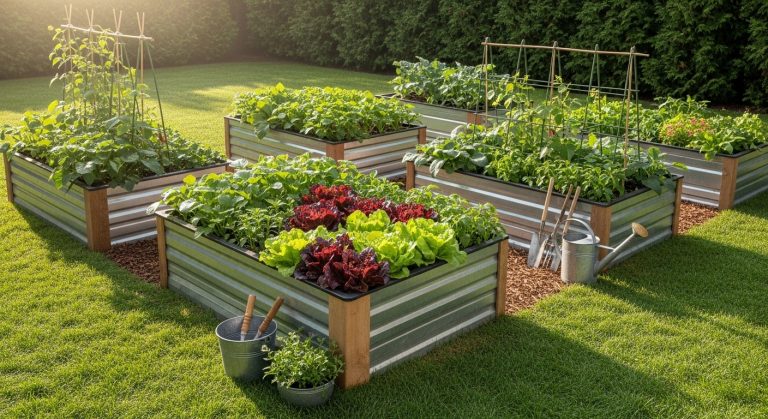Fairy Garden Pots: 15 Magical Ideas to Bring Whimsy to Your Home and Garden
Ever stumbled upon a fairy garden and felt that spark of childhood wonder light up inside you? That’s exactly how I felt when I made my first fairy garden pot. There’s just something about tiny doors, mossy paths, and miniature cottages that pulls you right out of the everyday grind and into something magical.
The best part? You don’t need a huge garden or fancy tools. With a few fairy garden pots, you can build your own little enchanted world — on your balcony, your porch, or even your desk. Whether you’re a green-thumbed gardener or just someone craving a creative outlet, these pint-sized worlds are pure joy to make.
Let’s explore 15 practical and enchanting fairy garden pot ideas you can try — each with a touch of creativity, honest pros and cons, and tips that make your next fairy pot project even more magical.
1. The Classic Terracotta Fairy Pot
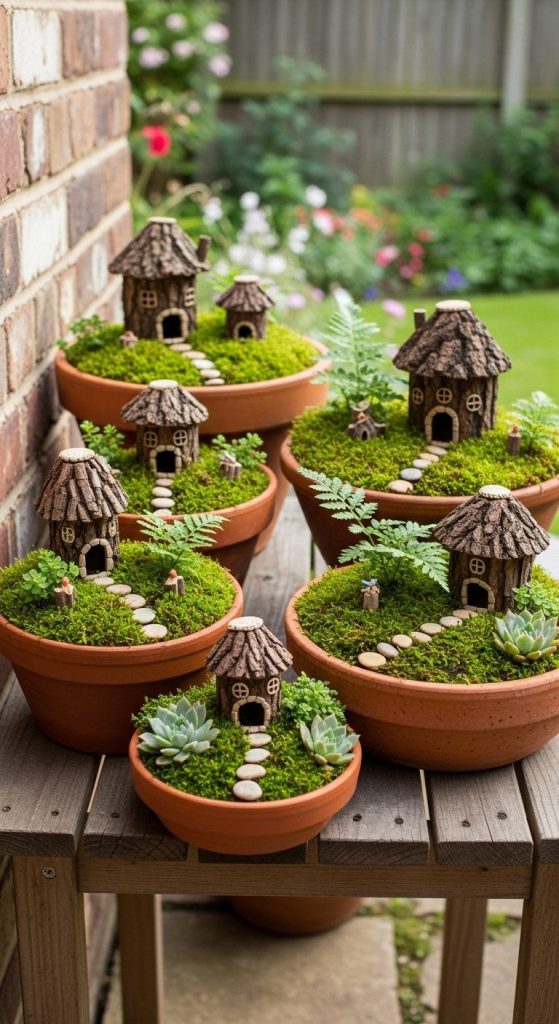
There’s something timeless about terracotta. It’s earthy, warm, and the perfect base for a fairy village.
Pros:
- Naturally porous — great for drainage and healthy plant roots.
- Easy to paint or weather for an aged, magical look.
- Budget-friendly and available in all shapes and sizes.
Cons:
- Can crack in freezing weather if left outdoors.
- Slightly heavier than plastic pots.
Takeaway:
If you’re starting your fairy garden journey, go terracotta. It’s the canvas of endless creativity — solid, affordable, and oh-so-charming.
2. Tiered Fairy Garden Pots for Vertical Magic
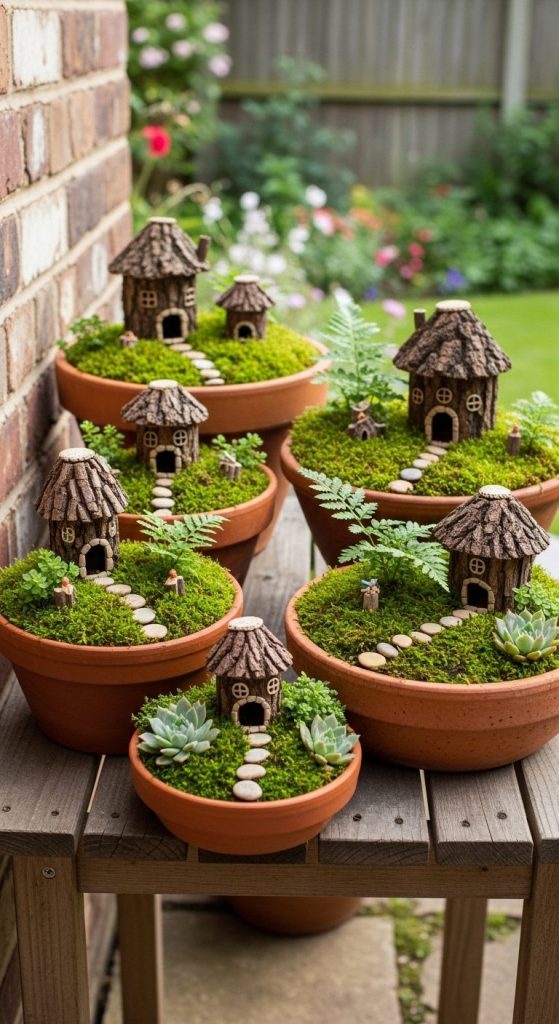
Running out of space? Stack your pots! A tiered fairy garden creates a vertical fairy world — think stairways to different realms.
Pros:
- Saves space — ideal for balconies or small patios.
- Looks stunning from any angle.
- Allows for storytelling: one tier can be a “forest,” another a “fairy village.”
Cons:
- Can become unstable if stacked too high.
- Requires careful watering to avoid runoff between tiers.
Takeaway:
Tiered pots turn limited space into a layered adventure — a fairy skyscraper, if you will.
3. Broken Pot Fairy Gardens (The Whimsical Accident)

Ever dropped a pot and thought it’s ruined? Think again! Broken pots are actually fairy garden gold.
Pros:
- Upcycles broken pottery into art.
- Natural ledges form perfect “terraces” for mini plants and paths.
- Looks effortlessly rustic and magical.
Cons:
- Fragile edges — handle with care when designing.
- Not ideal for plants that need deep soil.
Takeaway:
What looks broken can become beautiful — just like fairy magic itself.
4. Teacup Fairy Pots (Tiny but Mighty)
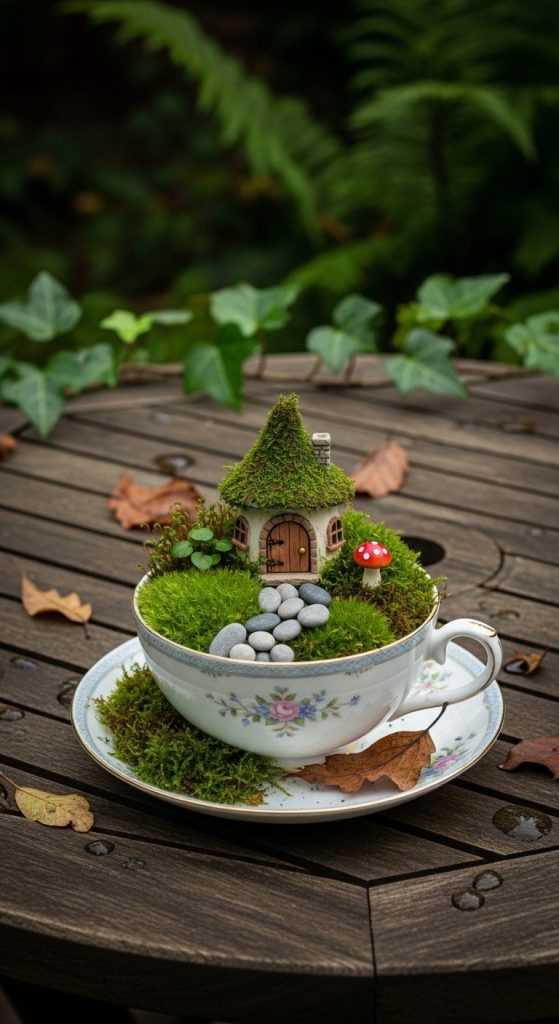
A teacup fairy garden is the perfect mini project when space is tight or time is short.
Pros:
- Adorable and great as gifts or decor.
- Needs minimal materials and soil.
- Perfect for tabletops, offices, or shelves.
Cons:
- Limited room for plants or decorations.
- Requires frequent watering since it dries quickly.
Takeaway:
Teacup fairy pots prove that magic doesn’t need space — just imagination.
5. Recycled Fairy Pots (Eco-Friendly and Unique)
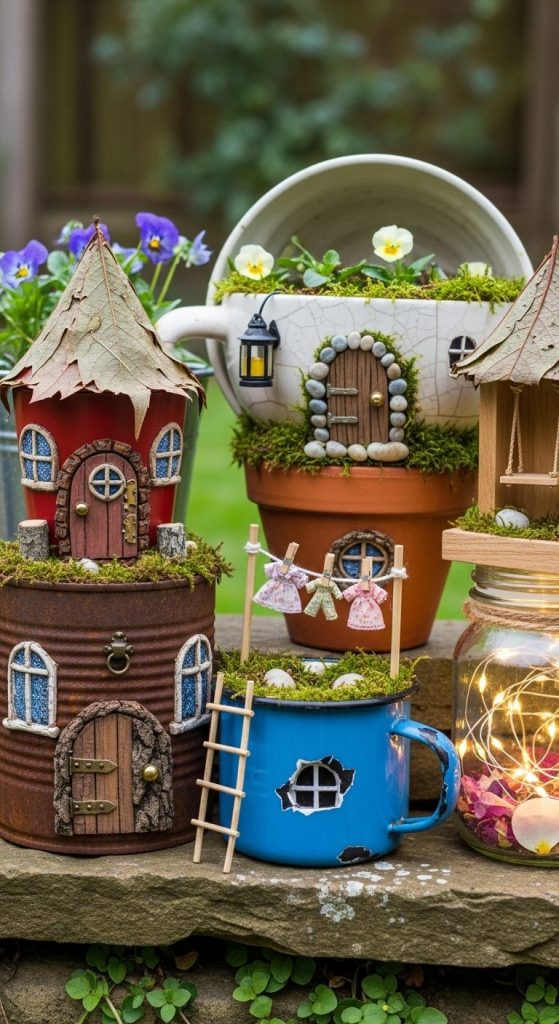
Before tossing that old tin or ceramic bowl, ask yourself — could it house a fairy village?
Pros:
- Promotes sustainability through creative reuse.
- Every pot has its own unique story and shape.
- Great conversation starter when guests notice your “upcycled art.”
Cons:
- Some materials (like metal) may rust or heat up under sun.
- Requires drainage holes if not already present.
Takeaway:
Give old containers new life — fairies love homes that tell stories.
6. Waterfall Fairy Pot (A Flowing Fantasy)

Nothing says “enchanted” like the sound of trickling water. Add a mini waterfall to your pot with a small pump or hidden pipe.
Pros:
- Adds sound, motion, and realism to your fairy world.
- Keeps air moist — great for moss and ferns.
- Visually soothing; perfect for relaxation corners.
Cons:
- Slightly higher maintenance — pumps need cleaning.
- May attract mosquitoes if water is stagnant.
Takeaway:
A waterfall fairy pot turns any corner into a tranquil, living fairytale scene.
7. Fairy Garden Pots with Succulents

Succulents and fairy gardens are a match made in heaven — low-maintenance yet stunningly detailed.
Pros:
- Drought-tolerant and easy to care for.
- Their compact shapes fit fairy-scale perfectly.
- Available in dreamy colors — pastel greens, purples, and blues.
Cons:
- Not ideal for shady, damp areas.
- Some varieties grow slowly or outgrow pots.
Takeaway:
Succulents make your fairy world thrive effortlessly — a smart choice for busy dreamers.
8. Moss-Covered Fairy Pots
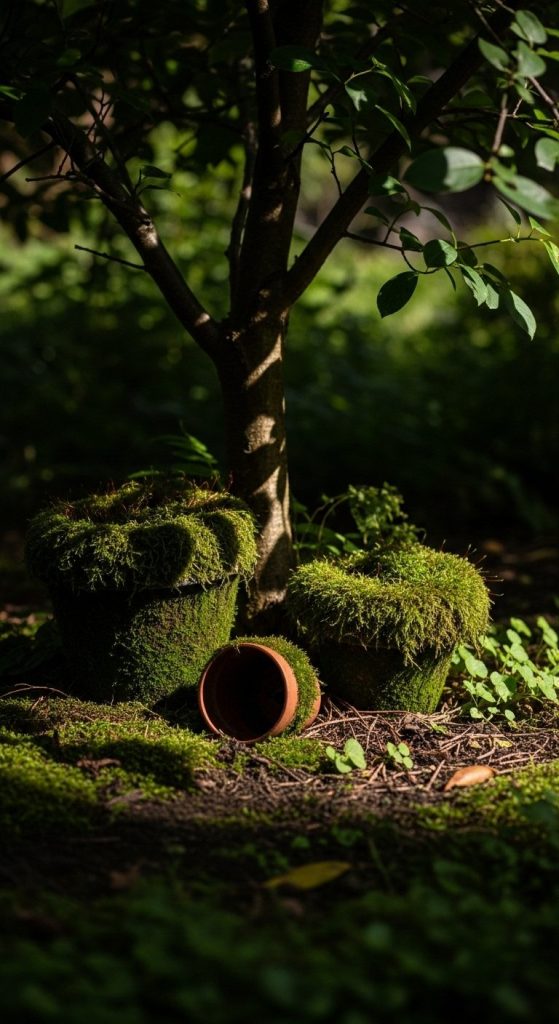
Moss adds that lush, woodland charm that instantly feels “fairy-approved.”
Pros:
- Instantly softens the look of any pot.
- Retains moisture, helping nearby plants.
- Looks magical — especially in shaded corners.
Cons:
- Needs consistent humidity or it dries out.
- Not ideal for sunny, hot areas.
Takeaway:
Add moss, and suddenly your pot whispers secrets of old forests and fairy trails.
9. Hanging Fairy Pots (Floating Worlds)
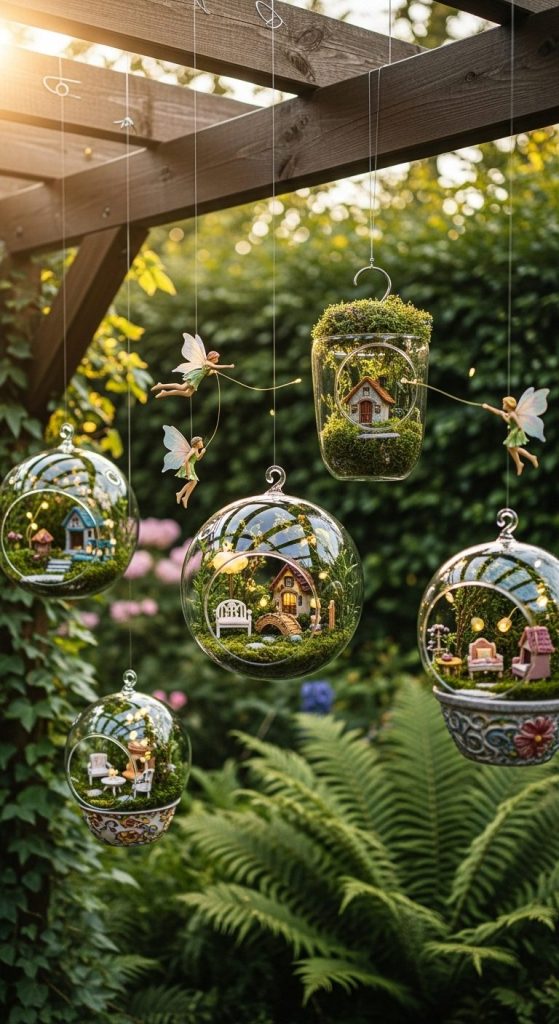
Who said fairy gardens must sit on the ground? Hanging pots create floating fairy realms that sway in the breeze.
Pros:
- Perfect for small patios or balconies.
- Creates visual depth and movement.
- Keeps fairies safe from pets or curious kids.
Cons:
- Needs strong hooks and balanced weight.
- Watering can be tricky — expect some dripping.
Takeaway:
Hanging fairy pots feel like mini worlds drifting through air — delicate, dreamy, and utterly magical.
10. Themed Fairy Pots (Seaside, Forest, or Cottagecore)
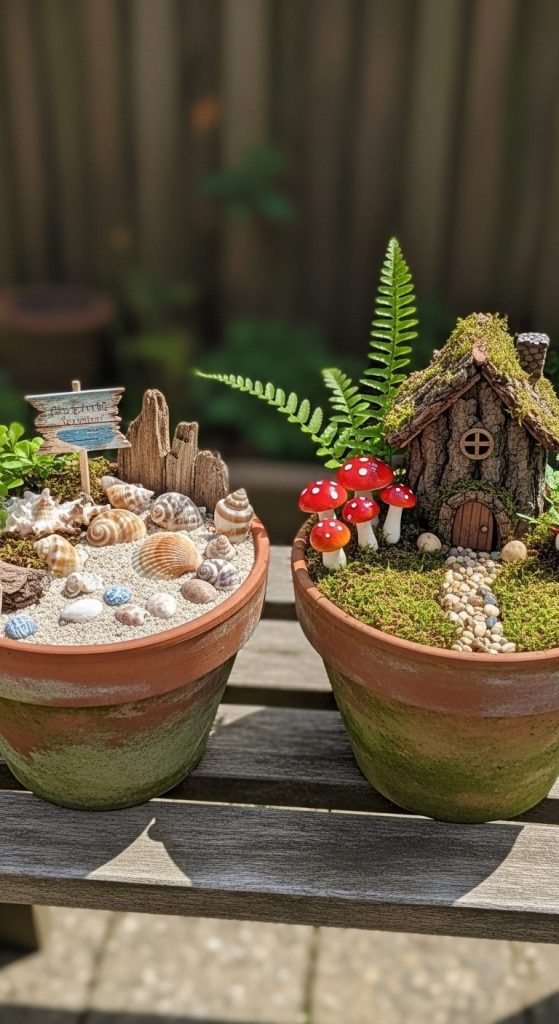
Themed pots help you tell a story — maybe a seaside fairy port or a forest hideaway.
Pros:
- Encourages creative storytelling.
- Lets you reuse small decor pieces like shells or stones.
- Visually cohesive and Instagram-worthy.
Cons:
- Harder to change once the theme is fixed.
- May look cluttered if overdecorated.
Takeaway:
Pick a theme and run wild. The fairies will appreciate your artistic vision.
11. Mini Lighting Fairy Pots (Nighttime Magic)

Fairy lights or solar-powered LEDs can make your garden glow after dusk.
Pros:
- Adds evening charm and visibility.
- Creates a cozy, inviting glow.
- Enhances mood — perfect for nighttime relaxation.
Cons:
- Battery or solar maintenance needed.
- Some lights can overpower delicate features.
Takeaway:
When the sun sets, your fairy garden doesn’t sleep — it sparkles.
12. Edible Fairy Pots (Herbs and Microgreens)
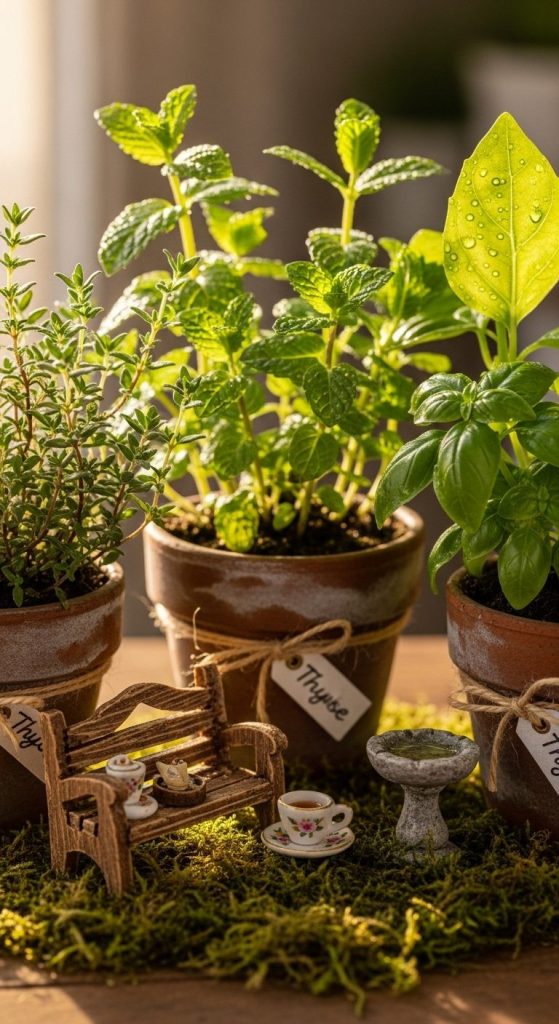
Yes, you can make a fairy garden that doubles as a mini herb patch!
Pros:
- Functional and decorative — beauty meets utility.
- Herbs like thyme, basil, and mint fit fairy scale perfectly.
- Smells divine, especially when brushed by hand.
Cons:
- Needs more frequent trimming.
- Some herbs outgrow small containers fast.
Takeaway:
Grow magic you can taste — your fairies will thank you for the aroma.
13. Storybook Fairy Pots

Bring your favorite tales to life — think Peter Pan, Alice in Wonderland, or your own fantasy world.
Pros:
- Infuses nostalgia and personal creativity.
- Perfect project for kids or themed parties.
- Keeps storytelling alive in a tangible, visual way.
Cons:
- Requires more planning for cohesive scenes.
- Might be delicate for outdoor placement.
Takeaway:
Every fairy pot tells a story — why not make yours unforgettable?
14. Fairy Garden Pots with Mini Pathways
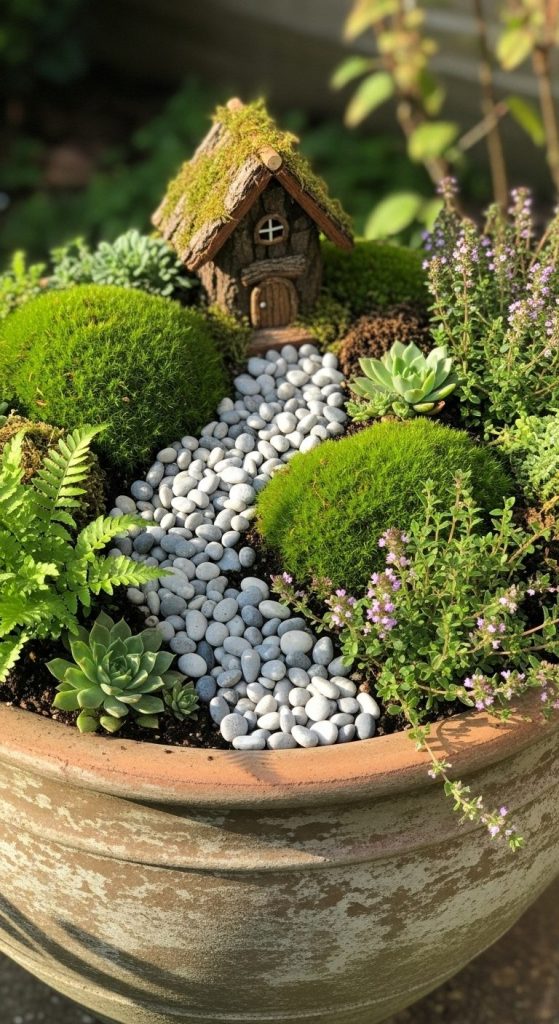
Adding a winding pebble path instantly gives your fairy world structure and realism.
Pros:
- Easy to design with pebbles, sand, or bark.
- Makes the layout look purposeful and balanced.
- Great detail for photography and social sharing.
Cons:
- Tiny paths shift easily during watering.
- Can trap dirt or moss between stones.
Takeaway:
A simple path transforms your fairy garden from “cute” to “convincing.”
15. Seasonal Fairy Pots (Changing with the Year)
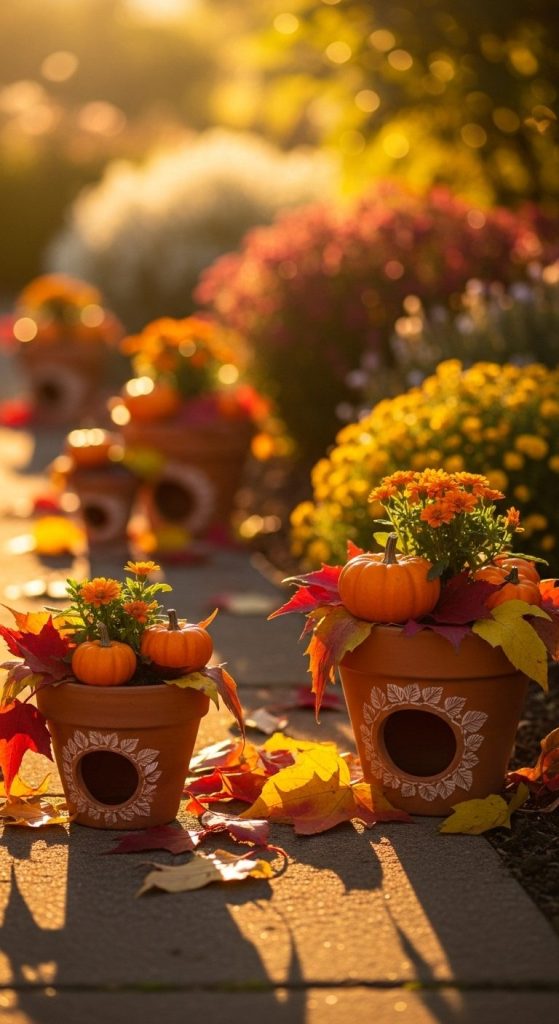
Why settle for one look all year? Switch up decor by season — snow for winter, flowers for spring, pumpkins for fall.
Pros:
- Keeps your garden fresh and exciting.
- Great excuse to decorate year-round.
- Reflects your mood and creativity through the seasons.
Cons:
- More upkeep if you change decorations often.
- Requires storage space for off-season items.
Takeaway:
Seasonal fairy pots evolve just like nature — always changing, always magical.
Final Thoughts: Where Magic Meets Mindfulness
At the end of the day, fairy garden pots aren’t just cute decor — they’re little reminders to slow down and find joy in small things. Building one feels therapeutic. You pick your plants, add your tiny doors, and watch a world come to life under your fingertips.
Whether you go for a rustic terracotta base or a hanging fairy paradise, the process is what matters most — connecting creativity, calmness, and that spark of childlike imagination we all still carry.
So grab a pot, some soil, and a sprinkle of fairy dust (metaphorically, of course ). Your next miniature masterpiece awaits.

William Martin is a passionate bowler who spends most of his weekends playing the sport. With years of intense experience under his belt, William decided to share his knowledge by creating BOWLING OCEAN. Join me on this journey to explore the world of bowling and discover the tips and tricks to becoming a pro.



